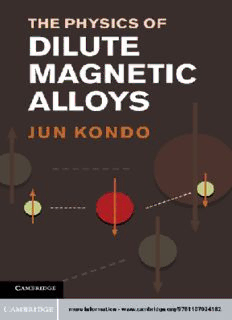
The Physics of Dilute Magnetic Alloys PDF
Preview The Physics of Dilute Magnetic Alloys
ThePhysicsofDiluteMagneticAlloys Available for the first time in English, this classic text by Jun Kondo describes the Kondoeffectthoroughlyandintuitively.Itsclearandconcisetreatmentmakesthisbook ofinteresttograduatestudentsandresearchersincondensedmatterphysics. Thefirsthalfofthebookdescribestherudimentsofthetheoryofmetalsatalevelthat isaccessibleforundergraduatestudents.Thesecondhalfdiscusseskeydevelopments in the Kondo problem, covering topics including magnetic impurities in metals, the resistance minimum phenomenon, infrared divergence in metals and scaling theory, includingWilson’srenormalizationgrouptreatmentandtheexactsolutionbytheBethe ansatz.AnewchapterhasbeenaddedcoveringadvancesmadesincetheJapaneseedition waspublished,suchasthequantumdotandheavyfermionsystems. jun kondo is Emeritus Professor of Toho University and Special Advisor at the NationalInstituteforAdvancedIndustrialScienceandTechnology(AIST),Japan,and a Member of the JapanAcademy. He is well known for solving the problem of the resistance minimum phenomenon, now known as the Kondo effect. Theoretical and experimentalstudiesinthisfieldcontinuetoday,andnewapplicationsforthetheoryare stillbeingfound. The Physics of Dilute Magnetic Alloys JUN KONDO MemberoftheJapanAcademy,Japan Translatedby ShigeruKoikegami,SecondLab,LLC KosukeOdagiri,NationalInstituteofAdvancedIndustrialScienceand Technology KunihikoYamaji,NationalInstituteofAdvancedIndustrialScienceand Technology TakashiYanagisawa,NationalInstituteofAdvancedIndustrialScienceand Technology cambridge university press Cambridge,NewYork,Melbourne,Madrid,CapeTown, Singapore,SãoPaulo,Delhi,MexicoCity CambridgeUniversityPress TheEdinburghBuilding,CambridgeCB28RU,UK PublishedintheUnitedStatesofAmericabyCambridgeUniversityPress,NewYork www.cambridge.org Informationonthistitle:www.cambridge.org/9781107024182 ©J.Kondo2012 Thispublicationisincopyright.Subjecttostatutoryexception andtotheprovisionsofrelevantcollectivelicensingagreements, noreproductionofanypartmaytakeplacewithoutthewritten permissionofCambridgeUniversityPress. Firstpublished2012 PrintedintheUnitedKingdomattheUniversityPress,Cambridge AcatalogrecordforthispublicationisavailablefromtheBritishLibrary LibraryofCongressCataloginginPublicationdata Kondo,Jun,1930– Thephysicsofdilutemagneticalloys/JunKondo;translatedby ShigeruKoikegami...[etal.]. p. cm. Includesbibliographicalreferencesandindex. ISBN978-1-107-02418-2(hardback) 1. Dilutealloys. 2. Magneticalloys. 3. Kondoeffect. 4. Freeelectrontheory ofmetals. I. Title. QC176.8.M3K66 2012 538(cid:1).4–dc23 2012014479 ISBN978-1-107-02418-2Hardback CambridgeUniversityPresshasnoresponsibilityforthepersistenceor accuracyofURLsforexternalorthird-partyinternetwebsitesreferredtoin thispublication,anddoesnotguaranteethatanycontentonsuchwebsitesis, orwillremain,accurateorappropriate. Contents Preface page ix Translators’foreword xi 1 Atoms 1 1.1 Mean-fieldapproximationandelectronicconfigurations 1 1.2 Multiplets 3 1.3 Coulombandexchangeintegrals 10 1.4 Hartree’smethod 13 Referencesandfurtherreading 14 2 Molecules 16 + 2.1 TheH molecule 16 2 2.2 TheH molecule 19 2 2.3 Theconfigurationinteraction 22 2.4 Secondquantization 25 Referencesandfurtherreading 30 3 TheSommerfeldtheoryofmetals 32 3.1 Classificationofsolids 32 3.2 TheSommerfeldtheory 36 Referencesandfurtherreading 48 4 Bandtheory 49 4.1 Theperiodicstructureofcrystals 49 4.2 Bloch’stheorem 52 4.3 Anapproachstartingfromthefreeelectronpicture 55 4.4 TheBlochorbitalasalinearcombinationofatomicorbitals 59 4.5 Metalsandinsulators 61 4.6 TheWigner–Seitztheory 63 v vi Contents 5 Magneticimpuritiesinmetals 69 5.1 Localchargeneutrality 69 5.2 Thesphericalrepresentation 72 5.3 Chargedistributionandthedensityofstates 78 5.4 Virtualboundstates 80 5.5 TheAndersonmodelI 84 5.6 TheAndersonmodelII 90 5.7 TheCoulombinteraction:UHF 97 5.8 ExpansioninpowersofU 104 5.9 s–dinteraction 106 5.10 Casewithorbitaldegeneracy 115 Referencesandfurtherreading 119 6 Theinfrareddivergenceinmetals 120 6.1 TheAndersonorthogonalitytheorem 120 6.2 Mahan’sproblem 124 6.3 ThethermalGreen’sfunction 127 6.4 ThermalGreen’sfunctionsinthepresenceoflocalpotentials 130 6.5 Thepartitionfunctioninthes–dproblem 132 6.6 TheNozières–deDominicissolution 134 6.7 Calculationofthepartitionfunction 136 6.8 Ascalingapproach 140 Referencesandfurtherreading 143 7 Wilson’stheory 144 7.1 Wilson’sHamiltonian 144 7.2 Perturbativeexpansions 150 7.3 Numericalcalculations:scaling 154 7.4 Susceptibilityandspecificheat 159 Referencesandfurtherreading 164 8 Exactsolutiontothes–dproblem 165 8.1 Aone-dimensionalmodel 165 8.2 Thethree-bodyproblem 168 8.3 Symmetricgroups 175 8.4 TheN-electronproblem 176 8.5 Antisymmetrization 179 8.6 Theeigenvalueproblem 182 8.7 Theintegralequation 185 8.8 Thegroundstate 187 8.9 Susceptibility 188 Contents vii 8.10 Universality 192 8.11 Theexcitedstates 195 8.12 Freeenergy 199 8.13 Specificheat 204 Referencesandfurtherreading 208 9 Recentdevelopments 209 9.1 Thespin-fliprate 209 9.2 Theheavyelectrons 211 9.3 Quantumdots 214 Referencesandfurtherreading 217 Appendices 218 A MatrixelementsbetweenSlaterdeterminants 218 B SpinfunctionforN-electronsystems 221 C Fourierexpansionofthree-dimensionalperiodicfunctions 224 D Proofofeq.(5.29) 225 E RelationsbetweenGreen’sfunctions 226 F ExpansionoffreeenergytoorderJ2 228 G Calculationofg± 234 H Feynman’stheorem 236 I Eliminationofadjacentpairs 237 J Proofofeq.(6.80) 239 K Transformationfromplane-waverepresentationto spherical-waverepresentation 240 L Derivationofeq.(7.33) 241 M Derivationofeq.(7.35) 241 N Solutiontotheeigenvalueproblemin§8.6 243 O Wiener–Hopfintegralequation 253 P Analyticcontinuationofeq.(8.82) 255 Q Rewritingeqs.(8.115)and(8.116) 256 Index 259
Description: